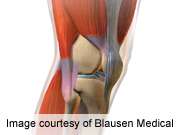In patients with osteoarthritis of the knee, changes in knee joint laxity during stair climbing or other repetitive physical activity and baseline body mass index are associated with disease progression, according to a study published online Aug. 8 in Arthritis & Rheumatism.
(HealthDay) -- In patients with osteoarthritis (OA) of the knee, changes in knee joint laxity during stair climbing or other repetitive physical activity and baseline body mass index (BMI) are associated with disease progression, according to a study published online Aug. 8 in Arthritis & Rheumatism.
Tsuyoshi Miyazaki, M.D., Ph.D., of the University of Fukui in Japan, and colleagues conducted a prospective study involving 136 patients with primary medial compartment knee joint OA to determine whether increased knee laxity during stair climbing or other physical activity is associated with knee joint OA progression. A total of 84 patients were reassessed for radiographic changes at eight years of follow-up.
The researchers found that antero-posterior knee laxity increased significantly after stair climbing. Before exercise, there was no difference in laxity for patients with and without progression. After exercise, there was a significant difference in the change in antero-posterior knee laxity and in baseline BMI for those with and without progression. Each extra mm change in antero-posterior knee laxity due to exercise correlated with a 4.15-times increase in the risk of progression of knee OA. Each point increase in BMI correlated with a 1.24-times increase in the risk of knee OA progression.
"Patients with progression of knee OA show increased knee laxity after a stair climbing exercise at baseline, suggesting that increased knee laxity during physical activity may play a significant role in the etiology and/or progression of knee OA," the authors write.
More information:
Abstract
Full Text (subscription or payment may be required)
Journal information: Arthritis & Rheumatism
Copyright © 2012 HealthDay. All rights reserved.




















